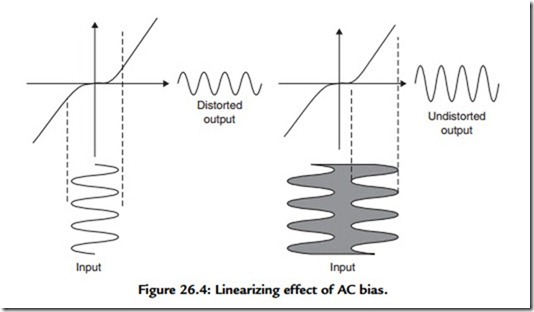Bias
If a sound recording and reproduction system is to perform without adding discernible distortion, a high degree of linearity is required. In the case of tape recording this implies the necessity for a direct relationship between the applied magnetic force and the resultant induction on the tape. Looking again at Figure 26.3, it is apparent that the only linear region over which this relationship holds is between B1 and B2, with the relationship being particularly nonlinear about the origin. The situation may be compared to a transistor amplifier, which exhibits a high degree of nonlinearity in the saturation and cut-off region and a linear portion in between. The essence of good design, in the case of the transistor stage, is appropriately to bias the amplifier in its linear region by means of a steady DC potential. And so it is with magnetic recording. In principle, a steady magnetic force may be applied, in conjunction with the varying force dependent
on the audio signal, thereby biasing the audio signal portion of the overall magnetic effect into the initial linear region of the BH loop. In practice, such a scheme has a number of practical disadvantages. Instead a system of ultrasonic AC bias is employed, which mixes the audio signal with a high-frequency signal current. This bias signal, as it is known, does not get recorded because the wavelength of the signal is so small that the magnetic domains resulting from it neutralize themselves naturally. It acts solely to ensure that the audio modulation component of the overall magnetic force influences the tape in its linear region. Figure 26.4 illustrates the mechanism.
It is hardly surprising that the amplitude of the superimposed high-frequency bias signal is important in obtaining the best performance from an analogue tape machine and a given tape. Too high an amplitude and high-frequency response suffers; too low a value and distortion rises dramatically. Different tape formulations differ in their ideal biasing requirements, although international standardization work [by the International Electrotechnical Commission (IEC)] has provided recommendations for the formulation of “standard” tape types.
